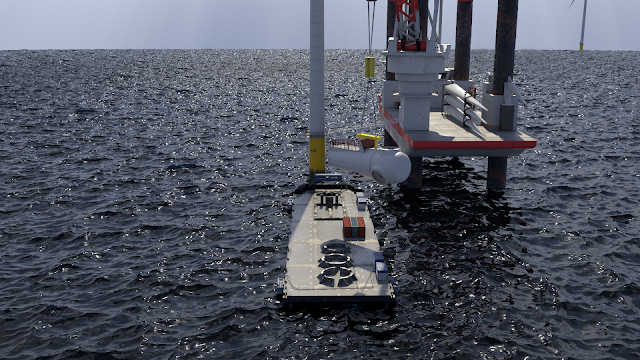
OWF Jones Act Vessel Line Up Misses the Mark for the American Waterfront
A gap exists between what the U.S. industry is asking for, local content, and what the industry currently offers for Jones Act compliant transport and installation solutions for offshore wind operations. Currently deployed vessel types, utilized in a new context, can bridge this gap and help build the future of offshore wind in the United States.
The combination of the United States’ environmental regulation, cabotage and local content, and equipment deficiencies in the offshore wind farm (OWF) market makes the industry ripe for innovation. However, the inevitable surge in demand that is to come for offshore renewable energy in the United States will be unleashed on a Jones Act infrastructure that only supports a fraction of the supply chain growth expected by the industry.
While offshore wind in the U.S. presents one of the most significant growth opportunities in history for merchant mariners and the shipbuilding market, there are no clear indications of how the existing Jones Act infrastructure will support these industries. The industry does not address how the Jones Act can be leveraged to reduce the levelized cost of energy (LCOE) for offshore wind while offering a comprehensive new build program with maximum economic benefit for the people of the project states.
For example, a Jones Act compliant wind turbine installation vessel (WTIV) can have an all-in cost upwards of 500mm USD. The carrying costs for an asset like this requires buy-in from not only politicians, but also fishing communities, local authorities, government agencies, and the people of the project state. Yet, a single WTIV working for an individual developer will only create a couple of hundred full time positions on/offshore, while perhaps installing only one of the proposed wind parks per season.
Aside from the substantial installation downtime resulting from high spec WTIVs ferrying components to/from shore, these vessels are limited and cannot reach many of the existing laydown areas and ports in operation. For example, TradePoint Atlantic- a facility primed for offshore wind-related manufacturing activity – is hindered by the Chesapeake Bridge, which creates an air draft restriction prohibiting WTIVs from calling the port.
Furthermore, as seen in Asia, offshore wind is becoming a global industry. With it, WTIV operators will see global demand and day rates will climb steadily. U.S. developers will have to keep WTIVs working as efficiently as possible and rethink transport and installation methods developed and utilized in Europe.
Does a Jones Act compliant WTIV offer value to the existing U.S. supply chain?
Some market indications point to yes. For example, Dominion Energy doubled down on the east coast plan to develop 5GW before 2035 with its own Jones Act installation vessel coming online in 2023. Still, questions remain: How is the whole industry benefiting from these decisions? Where does this leave the 2.9gw of planned Ørsted capacity? Are we producing the lowest LCOE for the end-users?
To date, the market’s answer to these questions has been alternate solutions such as motion-compensated platforms, lift boats, and giant feeder concepts. However, current lift boat capacities are insufficient nor environmentally friendly. Proposed new designs of giant lift boat feeder ships have the same restrictions as WTIVs and cost nearly as much.
Today, turbine installation is strictly performed under the current U.S. Jones Act interpretations, the possibility that foreign WTIVs can transit back and forth between load ports and offshore construction sites is undoubtedly out of the question. The Outer Continental Shelf Lands Act (OCSLA) and its interpretation by U.S. Customs and Border Patrol (CBP) clearly states that foreign-flagged installation vessels are unable to deliver wind turbine components from a U.S. marshaling and pre-assembly port to a monopile once it is connected to the seabed.
If this remains the case, it will be impossible to build out the proposed 13 offshore wind farms totaling 9.1GW power output along the east coast by 2026 [AWEA Status Update June 2020] with the only planned US-flagged installation vessel coming available no earlier than 2023.
Simply put, mathematically, the industry cannot achieve its lofty goals.
“The market needs a widely scalable solution that reduces barriers to entry for the local ports, fishing communities, shipyards, factories, and small businesses. As our world emerges from crippling economic hardship, we need to deliver immediate opportunities” said a spokesman from SEA.O.G.
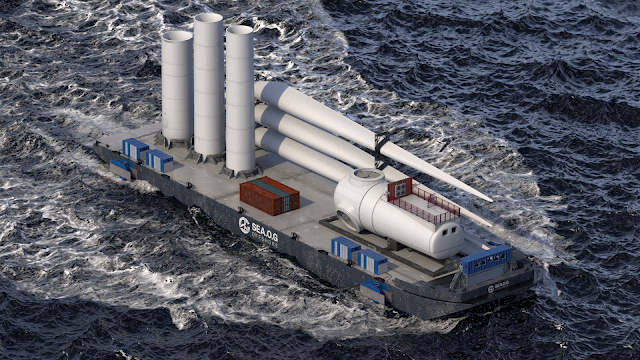
“There is a gap between what the industry is asking for, local content, and what the industry currently offers for transport and installation solutions. SEA.O.G‘s Autonomous Delivery and Installation Platform Technology (ADAPT) can that gap.”
A Practical Solution:
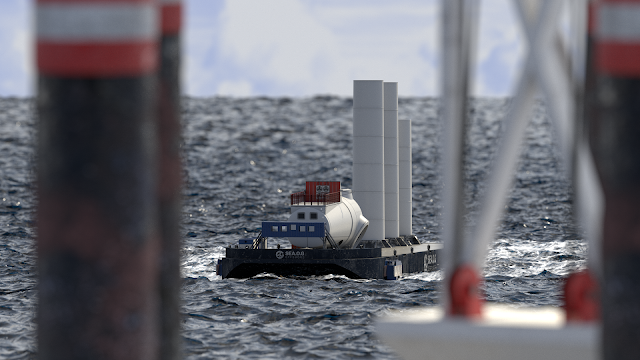
ADAPT combines maritime heritage with the most groundbreaking, innovative offshore technologies applied to standard-issue Jones Act equipment. SEA.O.G‘s ADAPT Developers can apply a direct and uniform strategy to promote more rapid, organic, and long-term growth of the maritime/ renewable energy industry. Maximizing the use of the existing Jones Act tug and barge fleet and their tenured manufacturing infrastructure and shipyards is a fast track to success for the local merchant mariners, shipbuilders, small businesses and overall sustainability of the U.S. OWF industry.
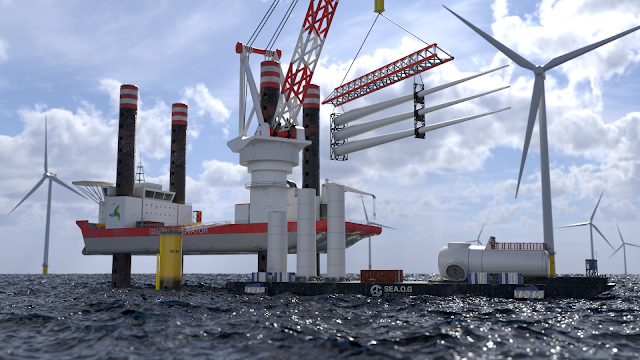
Applied Science:
There is one often underestimated, yet fundamental, hurdle to overcome – motions. Any ship sailing along our oceans and river systems is subject to induced 6 degrees of freedom (6DOF) movements by waves, currents, and wind. This hinders the safe and precise positioning of components during the construction phase. What makes a wind turbine installation vessel so unique is its ability to lower its legs into the seabed, followed by the jacking of its entire ship hull out of the water. This feat allows the WTIV to morph from a ship into a stable crane and installation platform. Now, what about the feeder barge?
Deck barges are traditionally used to transport heavy and oversized goods along coastlines or offshore construction sites. However, more than any other commercial ship hull design, a standard deck barge can transmit high accelerations on its cargo through extreme metacentric heights, high dampening coefficients, and short roll periods if not carefully considered during the planning process.
The industry’s current ask is to develop safe, efficient, and reliable barge feeder systems that allow safe rigging and lifting of various component types while operating in 2-2.5m significant wave height. These barge feeders must hold this standard, not through one unique lift, but repetitive lifts of potentially thousands of wind turbine components.
How it works:
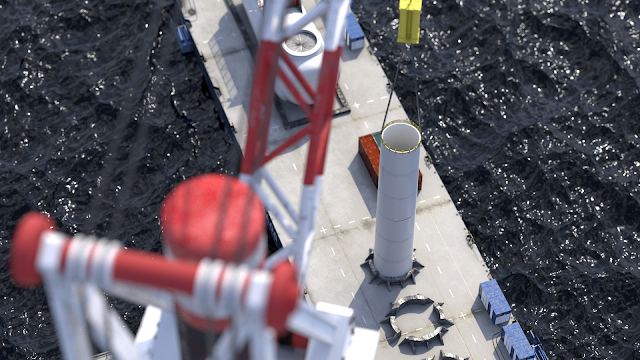
1. Barge Stabilization – Keeps the significant (extreme) roll angles below 0.5 degrees during beam seas with up to 2m significant wave height via state-of-the-art roll damping technology. Current data gathered provides motions during quarter seas up to 60 degrees at the same sea state can be considered near-zero value.
2. Self-Propelled DP2 capable – Allows transport of the barge from the loading port under its own power to the precise positioning of the barge alongside the WTIV with four Thruster and a DP2 system/operator.
3. Lifting Heave Compensation – Reduces potential dynamic amplification factors (DAF) in the lifting slings and enables a swift liftoff without the risk of collisions, all components can be lifted using a passive heave compensator (PHC) with quick-lift option attached to the hook of the WTIV. The displacement will keep the worst vertical motions (heave) in the range of +/- 0.2m.
4. Wave Prediction – Predicts waves by radar scans of the surrounding incoming waves and calculates accurate motions minutes ahead. Many heavy lifts in offshore construction sites are timed based on sole experience with the chance to get caught in dangerous events caused by sudden extreme waves. Now, we can look ahead for minutes and execute lifts while guaranteeing motions to be below pre-set thresholds.
5. Re-imagined Sea fastening – Frees blades, towers, and hub-nacelle assemblies from their sea fastening without human contact in seconds with self-release synchronized sea fastening (SRSS) undergoing study.
6. Autonomous communications – Communicates autonomously right to work criteria between vessels so that the feeding vessel is always aware of sea state, wind, WTIV Status, and location.
“Do what you can, with what you have, where you are.”
Theodore Roosevelt: An Autobiography
The industry should use the tools they have, repurposed in a new context, to build the offshore wind fleet’s future in the United States. The market does not need 500m Jones act ships when we can support a much broader swath of the existing tug and barge infrastructure. There are dozens of shipyards capable of delivering a barge every few months at this moment. The industry should leverage technology to make these barges as operationally safe as a platform out of the water.
Studies on floating feedering solutions agree that it is a viable solution, but the concept needs work. SEA.O.G has put in the work with thousands of hours of research and development. From using state of the art motion response analysis, to analyzing motions at certain points on the floating body, to operational risk analysis and implementation of administrative controls to improve safety and performance. The outcome generates the incredible potential for a wide variety of current industry heavy hitters as well as smaller new service providers:
7. ADAPT barges are able to deliver one complete (12-15mw) next generation turbine per barge. Furthermore, they can handle blade lengths up to 120m.
8. The ADAPT barges allow access to a greater variety of port locations ergo, creating factory to foundation opportunities. Reduce risk and cost by having options to avoid shuttling between factory and pre-assembly ports.
9. ADAPT barges can be used throughout several installation campaigns, installing monopiles, secondary structures, and using them for turbine installation, cable lay operations, or shuttle operations.
10. Promote existing infrastructure and shipyard capacities with a new building program.
11. Give local tug and barge operators a reduced barrier to entry.
12. Create state by state opportunities for local content and crew.
13. WTIV can spend an estimated 40% more time installing turbines. Reduce transit time and eliminate loading / seafastening risk/time.
14. Eliminate approximately 50% of jack-up operations and contact with the seabed compared to lift boats, creating a more environmentally friendly solution.
15. Accommodates delivery of a single next-generation turbines of up to 15MW daily. Two ADAPT barges could feed an installation vessel continuously, avoiding transit and port loading time and risk.
16. Develop several specialized positions for U.S. workers, from merchant mariners, riggers, safety, I.T., Shipbuilding.
17. Build cost <25mm USD
“From duct tape to Coca-Cola, some of the greatest inventions in history were discovered only to be repurposed for an even greater use. For the U.S. offshore wind industry to reach its goals, it needs to do just that. SEA.O.G’s ADAPT brings together the past with the present, ultimately catapulting the U.S. wind energy operations into the future.” Said a spokesman from SEA.O.G
